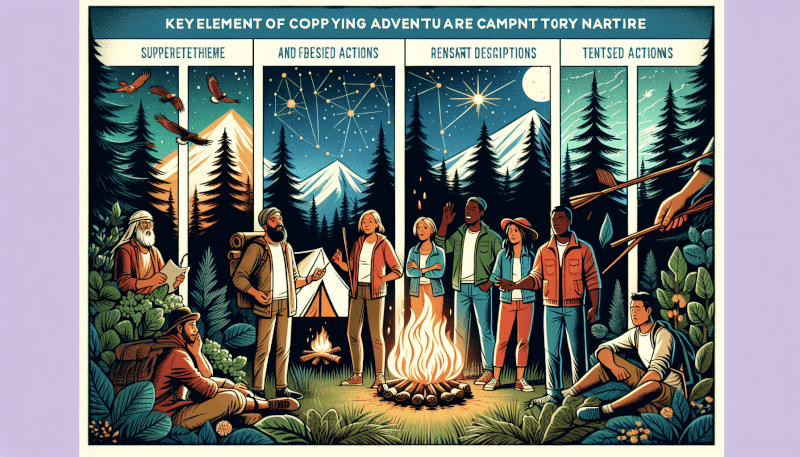Imagine yourself sitting around a crackling campfire, the stars twinkling above you, as you listen to the mesmerizing tales of thrilling camping adventures. If you’ve ever wondered how to transform your own outdoor experiences into captivating stories that leave your audience hooked, look no further. In this article, you will discover seven essential tips that will help you craft a gripping camping adventure story that will transport your readers to the heart of nature and leave them longing for their own wilderness escapades. So grab a marshmallow, settle in, and get ready to unleash your storytelling prowess under the open sky.

Setting the Scene
Choose a captivating location
When crafting a gripping camping adventure story, one of the first things you need to consider is the setting. Choosing a captivating location can make all the difference in engaging your readers. Whether it’s a secluded forest, a majestic mountain range, or a serene lakeside, the setting should evoke a sense of wonder and intrigue.
Provide vivid descriptions of the surroundings
To fully immerse your readers in the camping adventure, vivid descriptions of the surroundings are crucial. Paint a picture with your words, allowing your audience to feel like they are right there alongside the characters. Describe the towering trees, the scent of pine in the air, the gentle babbling of a nearby river, and the crackling of the campfire.
Include information about the weather
The weather can play a significant role in setting the mood and adding atmosphere to your camping adventure story. Is it a warm summer night, with a sky full of twinkling stars? Or perhaps the characters are battling through a torrential downpour, their tents barely withstanding the relentless rain. Including information about the weather further adds to the authenticity and excitement of the narrative.
Character Development
Create relatable and interesting main characters
To captivate your readers, it’s essential to create relatable and interesting main characters. Give them distinctive personalities, dreams, and flaws. Whether they are brave and adventurous or introverted and cautious, the main characters should feel like real individuals. Show their vulnerabilities and strengths, and let readers connect with their struggles and triumphs.
Develop secondary characters to add depth to the story
The main characters are crucial, but secondary characters add depth and richness to the camping adventure story. Create a diverse cast of supporting characters, each with their own unique traits and motivations. They can be fellow campers, local residents, or even mysterious figures encountered along the way. Developing these secondary characters will make the story feel more realistic and enhance the overall reading experience.
Show character growth throughout the adventure
To make the camping adventure story truly compelling, the characters must experience growth and change. As they face challenges and overcome obstacles, show how these experiences shape them. Characters should learn valuable lessons about themselves and others, gaining insights that transform their perspectives. By demonstrating character growth, you create a satisfying and gratifying narrative arc for your readers.
Plot Development
Build suspense and anticipation
A gripping camping adventure story thrives on suspense and anticipation. Keep readers on the edge of their seats by introducing mysterious elements or hinting at hidden dangers. Unveil secrets slowly, heightening the readers’ curiosity and driving them to uncover the truth alongside the characters. By building suspense and anticipation, you create a page-turning experience.
Include conflict and obstacles to overcome
No good story is complete without conflict and obstacles. Create challenges that test the characters’ resolve and push them beyond their limits. Whether it’s a treacherous hiking trail, encounters with wild animals, or conflicts within the group, these obstacles will make the camping adventure more thrilling and engaging. The characters’ journey becomes even more rewarding as they overcome these challenges.
Create a clear beginning, middle, and end
A well-structured camping adventure story has a clear beginning, middle, and end. Engage your readers from the start with an intriguing opening that sets the stage for the adventure to come. In the middle, intensify the stakes and deepen the conflicts. Finally, bring the story to a satisfying conclusion that resolves the main plotlines while leaving room for future adventures. An organized structure ensures a coherent and satisfying reading experience.
Engaging Dialogue
Use dialogue to reveal character traits and relationships
Dialogue can be a powerful tool for revealing character traits and relationships. Through their conversations, characters can express their hopes, fears, and dreams, giving readers insight into their personalities. Craft dialogue that is authentic and true to each character, reflecting their unique voice and perspective. Let the characters’ interactions reveal their dynamics and deepen their connections.
Include humor and banter to add entertainment value
Humor and banter can add entertainment value to your camping adventure story. Injecting moments of levity and wit can provide a welcome break from intense or dramatic scenes. Use humor to lighten the mood and make the characters more relatable. Clever banter between characters can also showcase their chemistry and strengthen their bonds, enhancing the overall enjoyment of the story.
Avoid excessive dialogue and ensure it drives the story forward
While dialogue can be an effective storytelling tool, it’s important to avoid excessive dialogue that detracts from the pacing and flow of the story. Each conversation should serve a purpose and drive the narrative forward. Make sure the dialogue contributes to character development, advances the plot, or provides essential information. Keeping dialogue concise and purposeful will keep readers engaged and invested in the adventure.

Tension and Conflict
Create internal conflicts within characters
Internal conflicts add depth and complexity to your characters. These personal struggles can stem from past traumas, moral dilemmas, or conflicting desires. By exploring their inner turmoil, you create a more nuanced portrayal of the characters. Internal conflicts add an extra layer of tension and make the characters’ journey more compelling and relatable.
Introduce external conflicts to drive the plot
External conflicts are essential for driving the plot forward and heightening the tension in your camping adventure story. These conflicts can come in the form of unexpected encounters with hostile wildlife, encounters with mysterious strangers, or even natural disasters. By introducing external conflicts, you create obstacles that test the characters’ resilience and determination, creating thrilling moments for readers.
Maintain a balance between tension and resolution
To maintain readers’ engagement, it’s crucial to strike a balance between tension and resolution. While tension and conflict add suspense and excitement, it’s equally important to provide moments of resolution and relief. Allow your characters to overcome obstacles and experience small victories along the way. This balance between tension and resolution keeps the story engaging and ensures readers remain invested in the outcome.
Action and Adventure
Incorporate thrilling and exciting moments in the story
A gripping camping adventure story should be filled with thrilling and exciting moments. Whether it’s a heart-pounding chase through the forest, a daring rock-climbing expedition, or a courageous stand against the forces of nature, these action-packed scenes will keep readers on the edge of their seats. Make sure each thrilling moment serves a purpose, driving the story forward and adding to the overall adrenaline rush.
Use descriptive language to immerse readers in the action
To fully immerse readers in the action and adventure, descriptive language is key. Paint a vivid picture of the fast-paced events unfolding, capturing the intensity and urgency of the moment. Engage all the senses, describing the rush of wind, the pounding heartbeat, and the taste of adrenaline. By using descriptive language, you transport readers right into the heart of the action.
Ensure the adventure is plausible within the camping setting
While it’s essential to create thrilling moments, it’s equally important to ensure that the adventure remains plausible within the camping setting. Maintain realism by considering the limitations and challenges of outdoor exploration. Balance excitement with practicality, incorporating thoughtful details that make the camping adventure feel authentic and believable.

Emotional Engagement
Evoke readers’ emotions through relatable experiences
To create an emotional connection with readers, evoke their emotions through relatable experiences. Whether it’s the characters’ fears, joys, or heartbreaks, make the audience feel deeply invested in their journey. Tap into universal emotions such as love, loss, and friendship, allowing readers to resonate with the characters’ emotional journeys. When readers care about the characters, they become emotionally engaged in the story.
Explore themes of friendship, courage, and self-discovery
Camping adventure stories often lend themselves well to exploring themes of friendship, courage, and self-discovery. Through the trials and tribulations of the characters, delve into the power of friendship, the bravery required to face the unknown, and the transformative nature of self-discovery. By exploring these universal themes, you create a resonant and meaningful narrative.
Create moments of triumph and heartbreak for the characters
A gripping camping adventure story should have moments of triumph and heartbreak for the characters. Celebrate their victories, both big and small, allowing readers to share in their joy and sense of accomplishment. Equally, make the characters face heartbreaking setbacks and losses, allowing readers to empathize with their pain and resilience. These emotional peaks and valleys create a rollercoaster of emotions, keeping readers emotionally engaged throughout the story.
Pacing and Structure
Maintain a steady pace to keep readers engaged
Pacing is crucial in a gripping camping adventure story. To keep readers engaged, maintain a steady pace that keeps the story moving forward. Balance slower, introspective moments with more action-packed scenes, ensuring there are no prolonged lulls. A well-paced story will hold readers’ attention and keep them eager to see what happens next.
Use chapter breaks or section divisions for structure
To provide structure to your camping adventure story, consider using chapter breaks or section divisions. These breaks create natural stopping points and allow for a sense of progression through the story. Each chapter or section can focus on specific events or challenges, creating a cohesive narrative structure that guides readers through the adventure.
Carefully balance action scenes with quieter moments
A gripping camping adventure story should include a careful balance of action scenes and quieter moments. While the action scenes provide excitement and thrill, the quieter moments allow for character development and reflection. Alternate between these two types of scenes to create a dynamic and well-rounded story that keeps readers engaged throughout.

Suspenseful Cliffhangers
End chapters or sections with cliffhangers to keep readers eager
Cliffhangers are a powerful tool to keep readers eager and invested in the story. End chapters or sections with suspenseful moments or unresolved conflicts, leaving readers wanting more. This technique creates a sense of urgency, compelling readers to continue reading to discover the resolution. By strategically placing cliffhangers, you ensure readers are eagerly turning the pages.
Utilize foreshadowing to hint at future twists and turns
Foreshadowing is an effective storytelling technique that can be used to hint at future twists and turns. By dropping subtle hints and clues throughout the story, you create a sense of anticipation and keep readers guessing. Foreshadowing builds suspense and excitement, making readers eager to uncover the secrets that lie ahead.
Resolve cliffhangers in a satisfying manner
While cliffhangers are essential for maintaining suspense, it’s crucial to resolve them in a satisfying manner. Provide answers to unresolved questions and outcomes to thrilling cliffhangers, ensuring that readers feel rewarded for their patience and investment. Balancing suspense and resolution keeps readers engaged and fulfilled throughout the storytelling experience.
Editing and Revising
Review and revise the story for clarity and coherence
Once you have completed your gripping camping adventure story, review and revise it for clarity and coherence. Ensure that the storyline flows smoothly, without any inconsistencies or plot holes. Check for any confusing or unclear passages, and refine them to enhance readability. A thorough review and revision process will polish your storytelling and make it more engaging for readers.
Ensure the storyline flows smoothly without inconsistencies
A well-crafted camping adventure story should have a cohesive and logical storyline. Ensure that all events and actions flow smoothly from one scene to another, creating a seamless narrative flow. Double-check for any inconsistencies or contradictions in the plot that may confuse or frustrate readers. A coherent storyline keeps readers immersed in the adventure.
Edit for grammar, spelling, and punctuation errors
No matter how captivating your camping adventure story may be, grammar, spelling, and punctuation errors can distract and diminish the reading experience. Take the time to thoroughly edit your story, checking for any mistakes and making necessary corrections. By eliminating these errors, you create a polished and professional final product that will impress and engage your readers.



